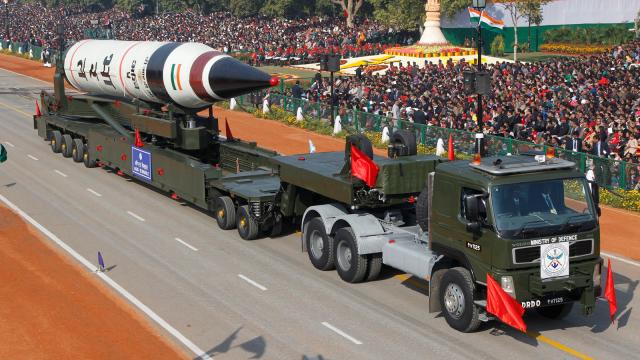India and China are the epitome of frenemies. Their relationship isn’t outright antagonistic, as India’s is with neighbouring Pakistan, but has remained prickly since an ongoing border dispute over Tibet that began in the 1960s. Which is why it could be a bit disconcerting that India’s newest missile can reach Beijing — not to mention deep into Europe.
The primary difference between the China and India’s missile programs has historically been a matter of range. China’s Dongfeng class of ICBMs, with a maximum range 3,000 km to more than 10,000 km, have long been able to penetrate the breadth of India’s airspace, while India’s short-range ballistic missiles have barely been able to get beyond Lhasa. And irradiating the capital city of the region you’re fighting over is rather counterproductive. But the advent of the new Agni-V ICBM, China’s cultural and economic centres are suddenly within India’s reach.
The Agni-V missile is the latest iteration of India’s ICBM line and has been developed by India’s Defence Research and Development Organisation (DRDO). The original Agni (“fire”) I and II ICBMs were short range units designed specifically to ruin Pakistan’s week. The medium range Agni III extended India’s nuclear strike range into Western China while the new Agni V (Agni-III* and Agni-IV were rolled into this model) can reach all the way to the Yellow Sea and into Europe.
The missile measures 57 feet in length by 6.5 feet in diameter, weighs 50 tons, and can carry a 3,300 pound nuclear warhead. Its three-stage solid fuel engine will generate 330 to 440 tons of thrust to boost the system into the upper atmosphere and back down again at speeds topping mach 24 with a maximum range of 5,500 km (1,500 km more than the Agni-IV). And while the current version can only carry a single warhead, future iterations will reportedly be armed with MIRVs (Multiple independently targetable reentry vehicles) which will carry multiple warheads that can split off from the main missile and target other cities.
The Agni-V also differs from its predecessors in that it is canister-launched and is designed to be easily manoeuvrable by truck or by rail. This eliminates the need for expensive, easilytargeted missile silos.
“The Agni-5 is specially tailored for road-mobility,” explained Avinash Chander, Director of the Advanced Systems Laboratory (ASL) in Hyderabad, to Rediff News. “With the canister having been successfully developed, all India’s future land-based strategic missiles will be canisterised as well.” In all, the Agni-V has cost a total of just 25 billion rupees ($383 million) to develop.
News of the Agni-V’s development first broke in 2007. By April 2012, an Agni-V prototype had successfully completed a 90 second test firing, the first of five test series the missile must pass before entering production by 2016. And in January of this year, the Indian government rolled out a reportedly operational unit for its annual Republic Day, along with a reminder to Pakistan not to take their friendship “for granted.” Yeah, real friendly.
Last week, India performed a second successful test-firing of the missile. “The test was successful,” Ravi Kumar Gupta, spokesman for the DRDO, said in a press statement Sunday. “It hit the target in a predefined trajectory. It met all the mission objectives.”
Now whether the regional security balance will be upset by the imminent production of this new ICBM remains to be seen. On one hand, this system merely incrementally augments India’s nuclear deterrent capability, it doesn’t impart any huge new tactical advantage.
“The existence of the Agni-V does not change the weapons requirements of any of India’s potential foes,” Christopher Clary, a former country director for South Asian affairs in the Office of the Secretary of Defence, told the Global Security Newswire. “China already has long-range missiles and Pakistan can credibly threaten Indian commercial and political centres with its existing systems. ”
On the other hand, this development could well inflame Pakistan and India’s nearly seven decade-long tensions and potentially accelerate the arms race between the two nuclear-powered nations. Even worse, it could lead to even greater instability in an already unstable region. So, there’s that. But at least it looks impressive in a parade. [Gavari Gujarat – Al Jazeera – Wikipedia– Times of India]
